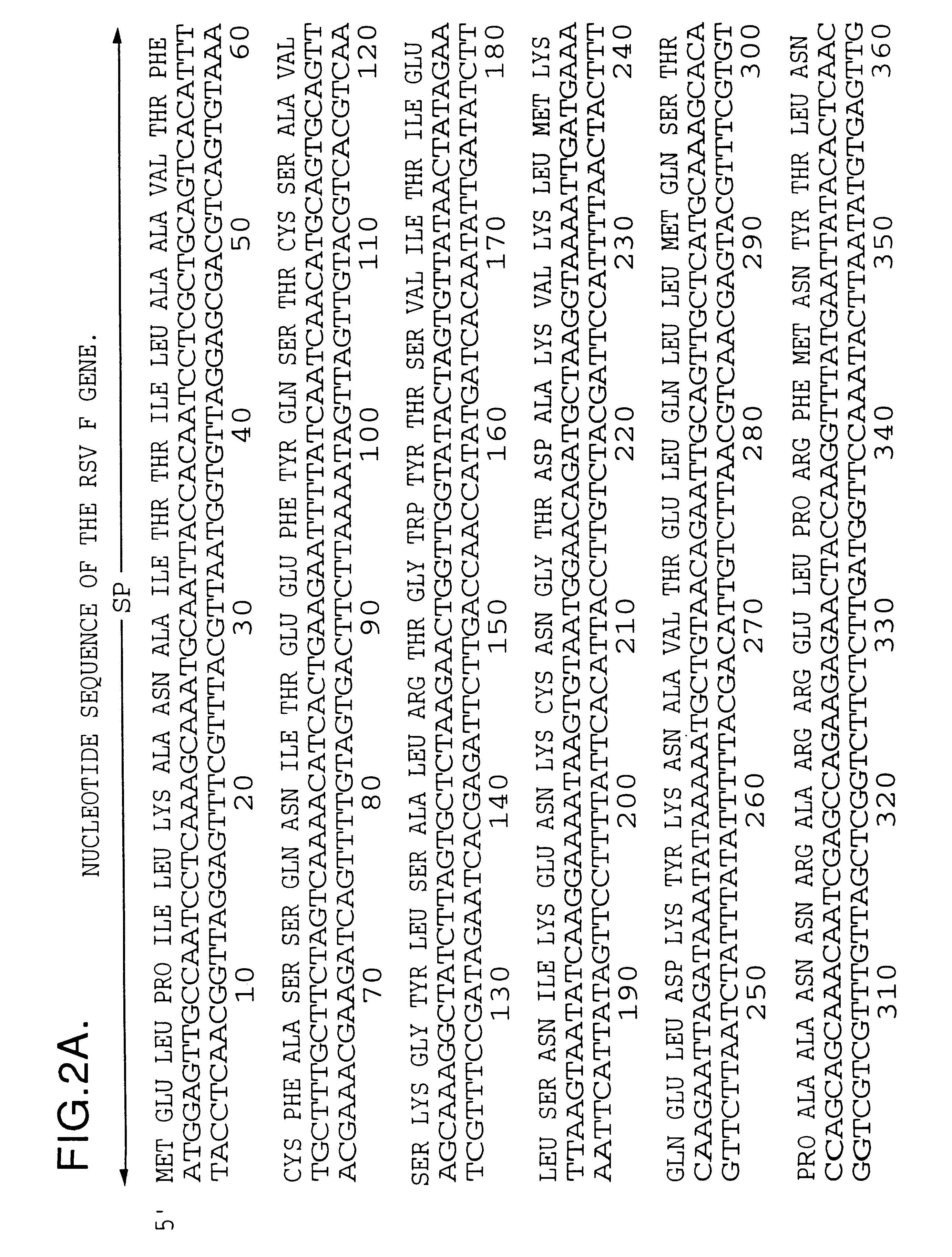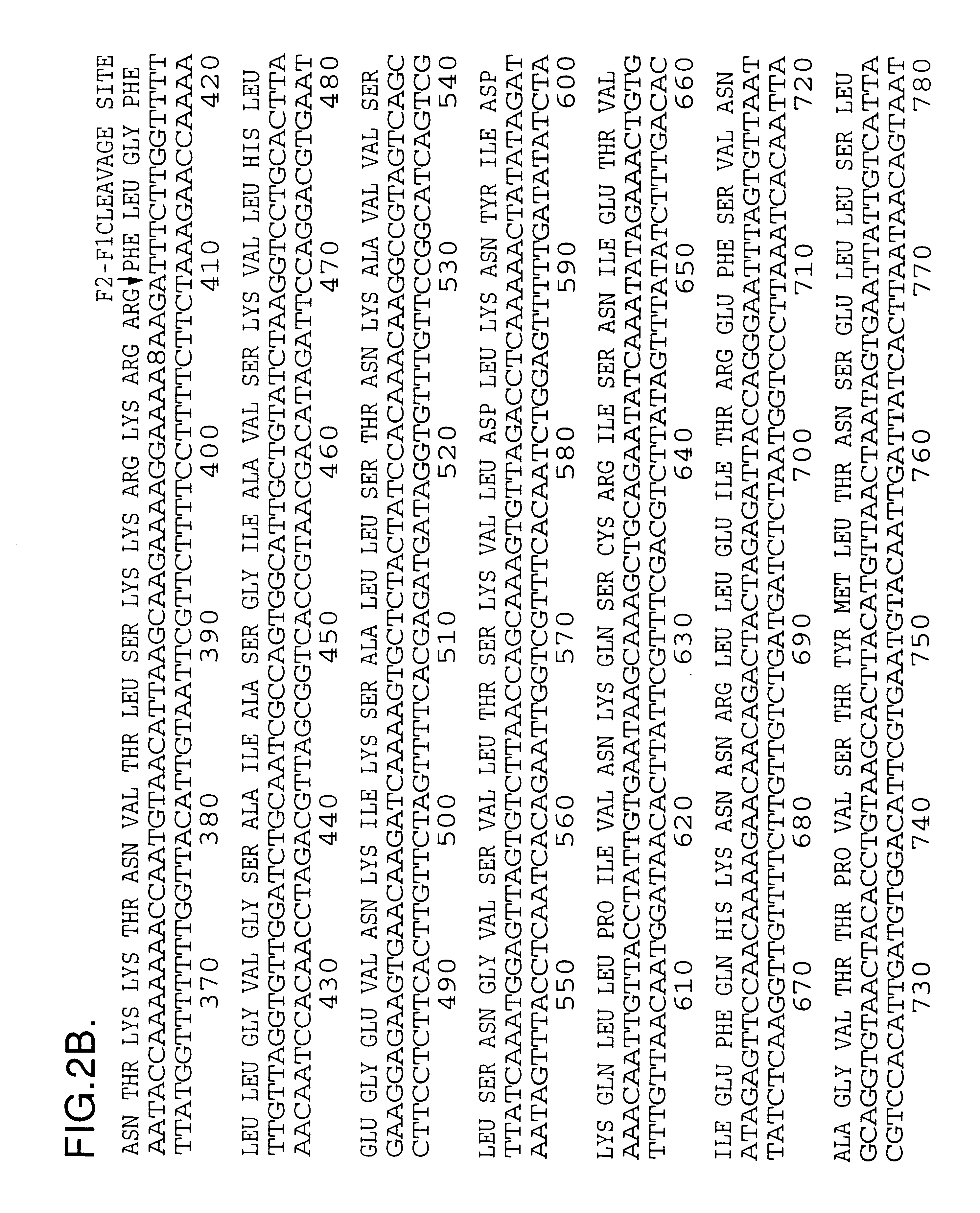Nucleic acid respiratory syncytial virus vaccines
a technology of respiratory syncytial virus and vaccine, which is applied in the field of nucleic acid respiratory syncytial virus vaccine, can solve the problems of inability to license the vaccine against rsv, the use of rsv proteins as vaccine candidates may have obstacles, and the vaccine candidates for parenteral administration have so far been poorly immunogenic. , to achieve the effect of increasing the immunoprotective ability of the rsv f protein, increasing in vivo expression, and increasing the stability
- Summary
- Abstract
- Description
- Claims
- Application Information
AI Technical Summary
Benefits of technology
Problems solved by technology
Method used
Image
Examples
example 1
This Example describes the construction of vectors containing the RSV F gene.
FIG. 1 shows a restriction map of the gene encoding the F protein of Respiratory Syncytial Virus and FIG. 2 shows the nucleotide sequence of the gene encoding the full-length RSV F protein (SEQ ID No: 1) and the deduced amino acid sequence (SEQ ID No: 2). FIG. 3 shows the gene encoding the secreted RSV F protein (SEQ ID No: 3) and the deduced amino acid sequence (SEQ ID No: 4).
A set of four plasmid DNA constructs were made (as shown schematically in FIGS. 4 to 7) in which cDNA encoding the RSV-F was subcloned downstream of the immediate-early promoter, enhancer and intron A sequences of human cytomegalovirus (CMV) and upstream of the bovine growth hormone (BGH) poly-A site. The 1.6 Kb Sspl-PstI fragment containing the promoter, enhancer and intron A sequences of CMV Towne strain were initially derived from plasmid pRL43a obtained from Dr. G. S. Hayward of Johns Hopkins University (ref. 20) and subcloned bet...
example 2
This Example describes the immunization of mice. Mice are susceptible to infection by RSV as described in ref. 16.
For intramuscular (i.m) immunization, the anterior tibialis anterior muscles of groups of 9 BALB / c mice (male, 6-8 week old) (Jackson Lab., Bar Harbor, Me., USA) were bilaterally injected with 2.times.50 .mu.g (1 .mu.g / .mu.L in PBS) of pXL1-4, respectively. Five days prior to DNA injection, the muscles were treated with 2.times.50 .mu.L (10 .mu.M in PBS) of cardiotoxin (Latoxan, France). Pretreatment of the muscles with cardiotoxin has been reported to increase DNA uptake and to enhance the subsequent immune responses by the intramuscular route (ref. 24). These animals were similarly boosted a month later. Mice in the control group were immunized with a placebo plasmid containing identical vector backbone sequences without the RSV F gene according to the same schedule. For intradermal (i.d.) immunization, 100 .mu.g of pXL2 (2 .mu.g / .mu.L in PBS) were injected into the sk...
example 3
This Example describes the immunogenicity and protection by polynucleotide immunization by the intramuscular route.
To characterize the antibody responses following i.m. DNA administration, immune sera were analyzed for anti-RSV F IgG antibody titre by ELISA and for RSV-specific plaque reduction titre, respectively. All four plasmid constructs were found to be immunogenic. Sera obtained from mice immunized with pXL1-4 demonstrated significant anti-RSV F IgG titres and RSV-specific plaque reduction titres as compared to the placebo group (Table 1 below) (P<0.0061 and <0.0001, respectively, Mann-Whitney Test). However, there is no significant difference in either anti-RSV F IgG titre or RSV-specific plaque reduction titre among mice immunized with either pXL1, pXL2, pXL3 or pXL4.
To evaluate the protective ability of pXL1-4 against primary RSV infection of the lower respiratory tract, immunized mice were challenged intranasally with mouse-adapted RSV and viral lung titres post challenge...
PUM
| Property | Measurement | Unit |
|---|---|---|
| temperatures | aaaaa | aaaaa |
| length | aaaaa | aaaaa |
| mRNA stability | aaaaa | aaaaa |
Abstract
Description
Claims
Application Information
 Login to View More
Login to View More - R&D
- Intellectual Property
- Life Sciences
- Materials
- Tech Scout
- Unparalleled Data Quality
- Higher Quality Content
- 60% Fewer Hallucinations
Browse by: Latest US Patents, China's latest patents, Technical Efficacy Thesaurus, Application Domain, Technology Topic, Popular Technical Reports.
© 2025 PatSnap. All rights reserved.Legal|Privacy policy|Modern Slavery Act Transparency Statement|Sitemap|About US| Contact US: help@patsnap.com



